MONOCULAR MICROSCOPE WITH BUILT-IN MECHANICAL STAGE
MAKER: SPENCER
c.1933
Author, and Collection of: Barry Sobel
Editor: Joseph Zeligs
Please Click On Any Picture for a Larger Version and Additional Images Where Available
DESCRIPTION:
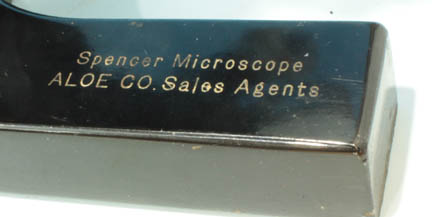 This monocular compound microscope, made by Spencer in the 1930s, is of a type specifically marketed to physicians and veterinarians. It is signed on the black foot:
This monocular compound microscope, made by Spencer in the 1930s, is of a type specifically marketed to physicians and veterinarians. It is signed on the black foot: Spencer Microscope, ALOE CO. Sales Agent
. Its serial number dates it to 1933.
The microscope is built upon a horseshoe foot which is a single casting with the upright supporting pillar. It inclines via a trunnion joint with lacquered brass nuts adjustable with a spanner wrench. The plano and concave mirror sits at a fixed distance from the stage but is on a swinging support attached to the portion of the limb extending below the stage.
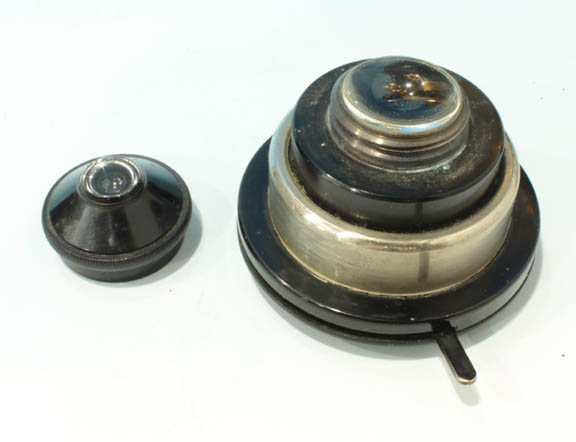
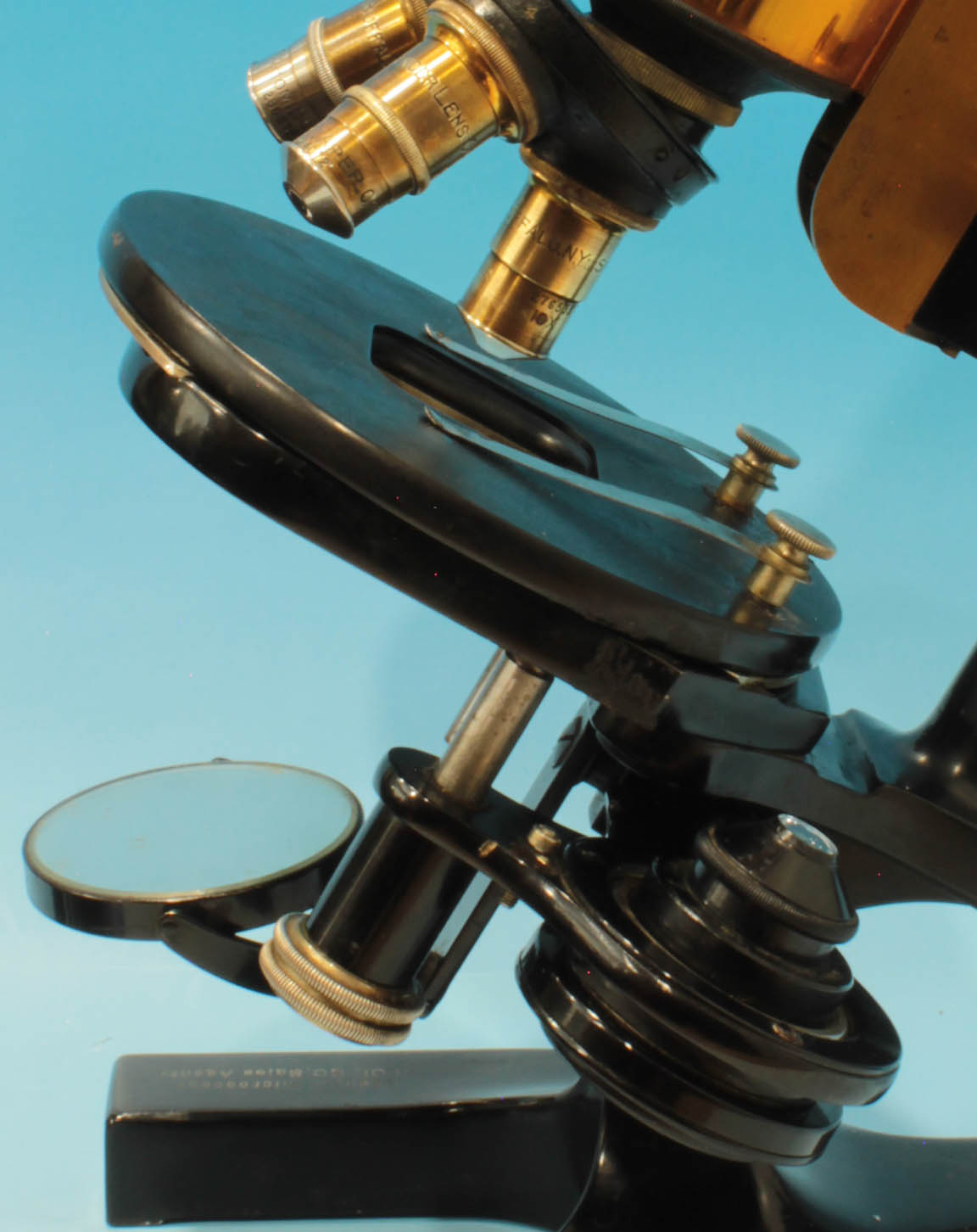
The removeable Abbe-type condenser (left) has a removeable top lens so it can be used for low power work, and has an adjustable iris diaphragm. It is installed in a quick screw
substage mount,(which focuses the condenser), and is seen here to the right. As shown in that image, when lowered to the bottom, the condenser mount can swing away from the optical axis. It has a slot on the bottom which will accept the included dark-ground stop or the glass blue filter.
The integrated mechanical stage was introduced about 1929. The mechanical stage is controlled by nickel-plated cross-knurled (a.k.a. diamond-knurled) knobs on the right side of the stage. The stage is covered with hard rubber. There are two chrome or nickel-plated stage clips held onto the stage via knurled screws.
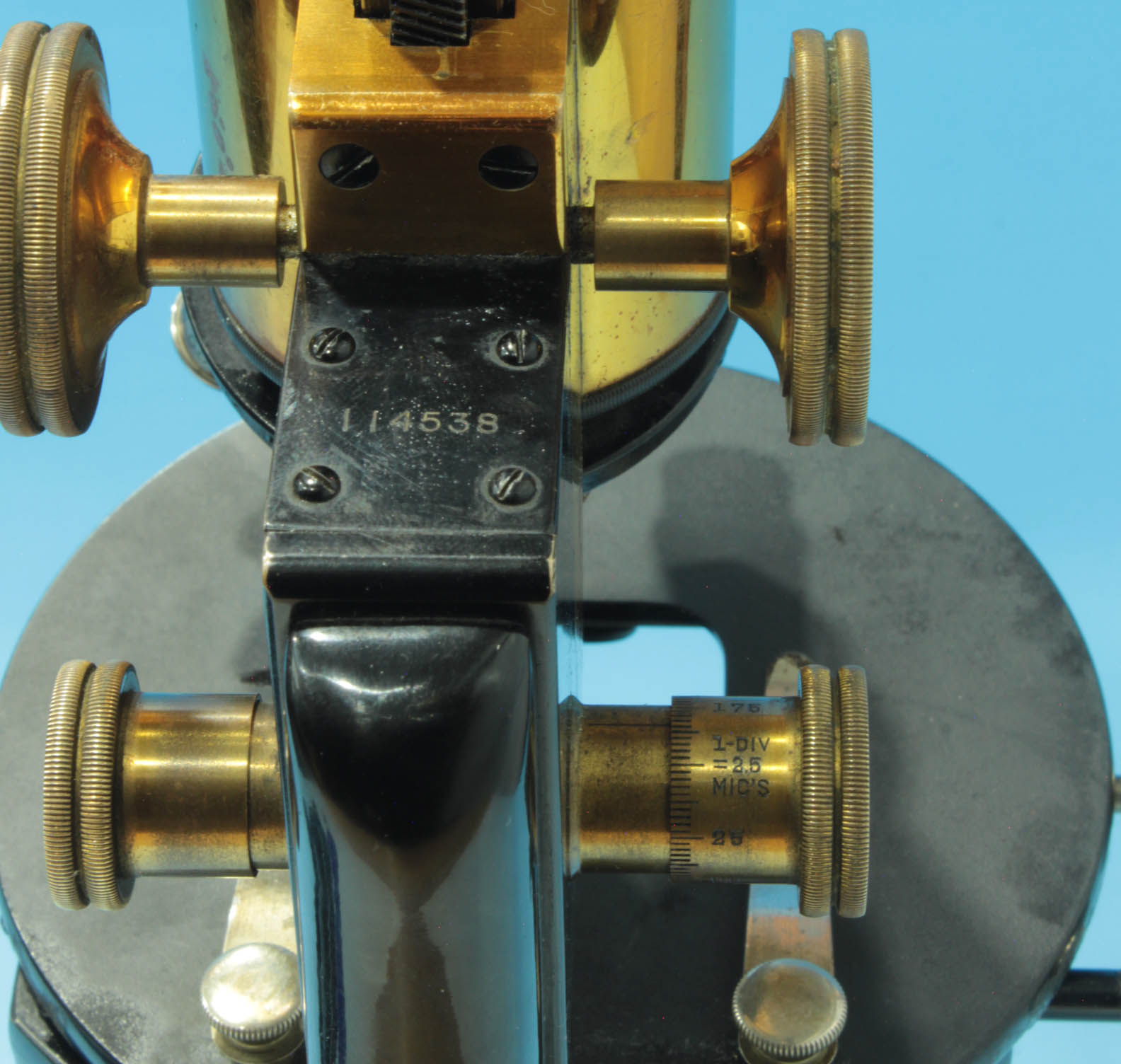 The limb supports the fine focus, the knob of which is calibrated in 2.5 micron increments, labeled every 25 and ranging from 0 to 175. The serial number 114538 is inscribed on a plate at the top of the fine focus box. Coarse focus is by diagonal rack and pinion. Unlike the mechanical stage controls, the coarse and fine focus knobs are lacquered brass with the earlier horizontal knurling.
The limb supports the fine focus, the knob of which is calibrated in 2.5 micron increments, labeled every 25 and ranging from 0 to 175. The serial number 114538 is inscribed on a plate at the top of the fine focus box. Coarse focus is by diagonal rack and pinion. Unlike the mechanical stage controls, the coarse and fine focus knobs are lacquered brass with the earlier horizontal knurling.

The lacquered brass main optical tube is larger than standard tubes, being 2 inches on outer diameter. The larger tube diameter is useful for photography and also for projection. It carries a black drawtube, calibrrated from 15 to 19 mm, labeled at 15, 16, and 17 with a line at 16,indicating a standard 160 mm tube length.
A triple objective changer is installed on the nosepiece. It carries three objectives. These are a 10X, 44X and a 95X oil immersion lens. Each is marked with their focal length, magnification, and n.a. and signed Spencer Lens Co. Buffalo N.Y.
. They are lacquered brass, but the oil immersion lens has a nickel plated lower half. Each objective is supplied with its own black metal can, with the focal lengths engraved in mm, in white letters on the top.
Two eyepieces are included, they are by Spencer, but not signed except with their magnification, 6X and 10X respectively.
The original leatherette-covered case is included and features an integrated slide box at the bottom. It has a true leather handle.
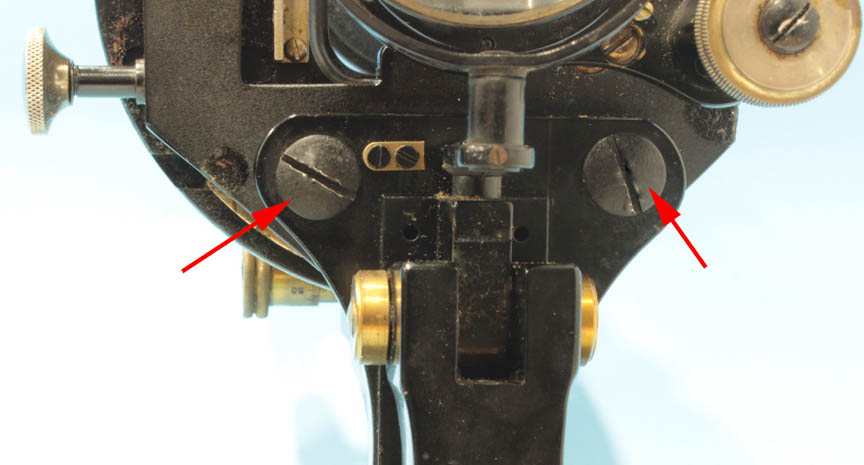 Since the condenser assembly is attached to the bottom of the stage,centering the condenser in the optical axis of the microscope is achieved by loosening the two large screws under the stage holding the stage in place indicated by the arrows to the left. As the author discovered, this is not an easy adjustment to make and requires a great deal of patience! Apparently this adjustment was made at the factory and was assumed to be permanent, but over time it drifted and the author spent quite some time recentering it.
Since the condenser assembly is attached to the bottom of the stage,centering the condenser in the optical axis of the microscope is achieved by loosening the two large screws under the stage holding the stage in place indicated by the arrows to the left. As the author discovered, this is not an easy adjustment to make and requires a great deal of patience! Apparently this adjustment was made at the factory and was assumed to be permanent, but over time it drifted and the author spent quite some time recentering it.
HISTORY:
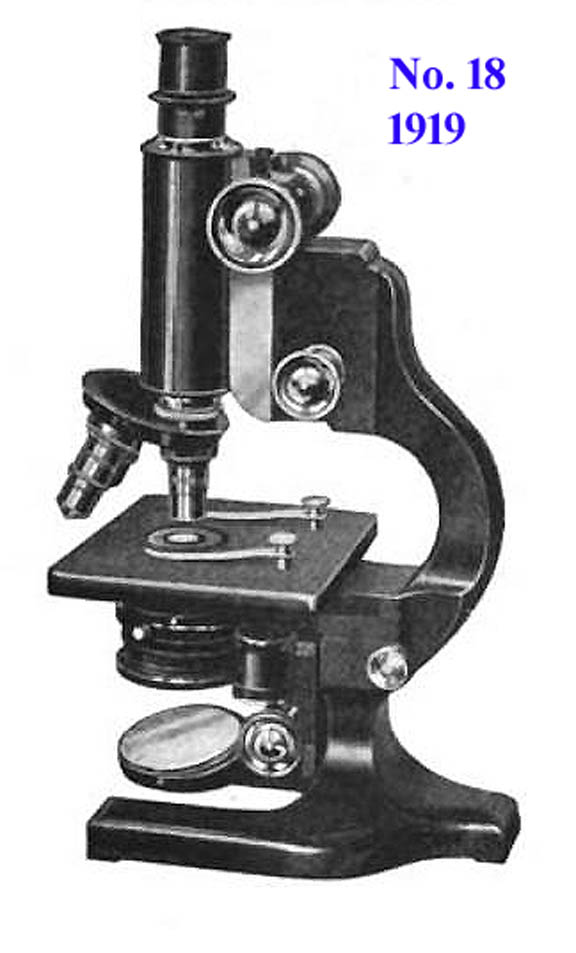
The number 18 was first introduced around 1919 at which time it had a standard diameter tube and a rack and pinion substage.
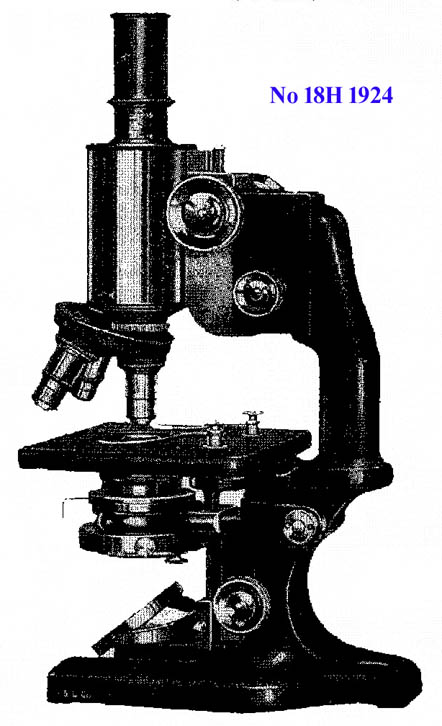
In the 1924 Spencer catalog entry, this microscope was now shown with the larger diameter 2 inch optical tube with the old-fashioned lacquered brass finish. Although by that time, most Spencer microscopes no longer featured a lacquered brass finish, this microscope, with its lacquered brass optical tube, focusing knobs, and part of the arm, was touted in the 1924 catalog entry as ideal ...for the physician's office where dignified appearance as well as utility are matters of prime importance
.
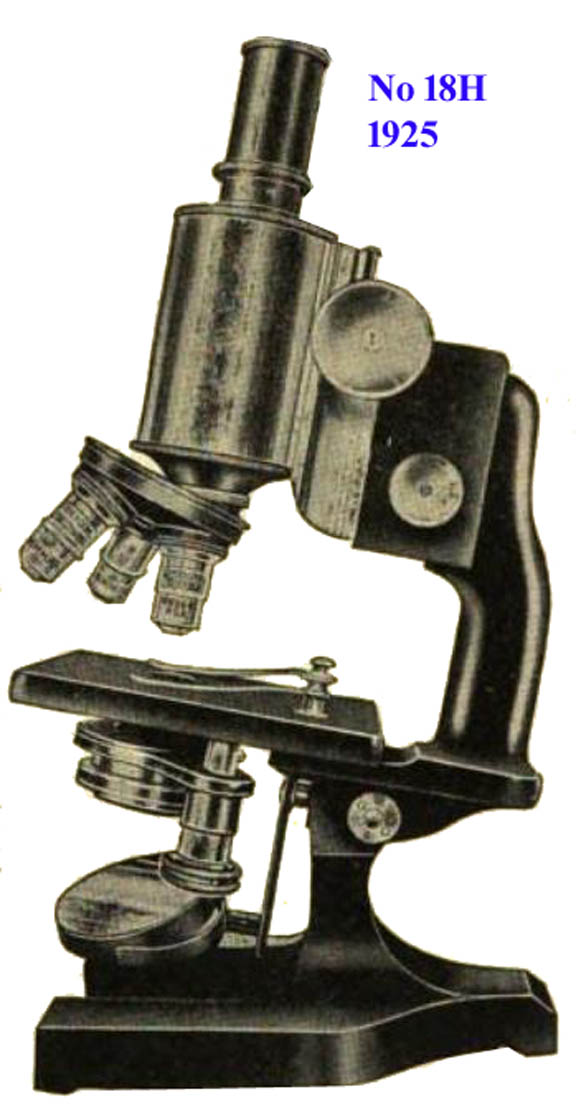
In advertisements of 1925 through 1927 it was advertised as the No. 18H and had the simple quickscrew
substage, just as the model shown at the top of this page, and continued to have a wide lacquered brass optical tube.
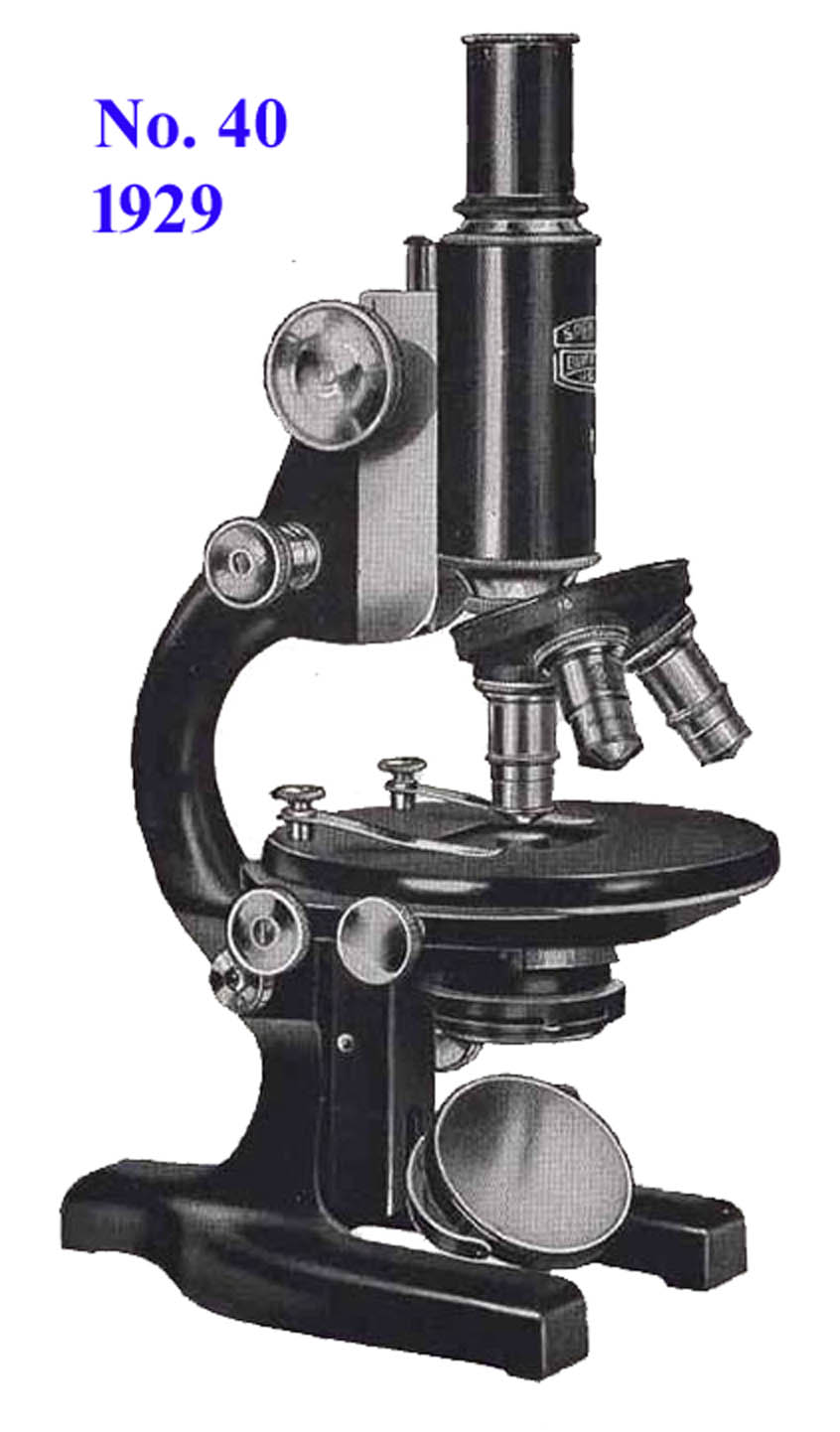
By about 1929 the Model No 18H was no longer touted in the Spencer catalog entry as the most ideal for physicians, the No 40 became The Advanced Laboratory and Physician's Microscope
. The No 40 model no longer had a wide tube and no longer had any part with a lacquered brass finish, and came with the new built-in mechanical stage. Yet as we know from the example at the top of this page, the wider tube and lacquered brass example was still being made as late as 1933, at least for sale via the Aloe company.
For a history of the Spencer companies, and their successors, see the article on the Spencer Companies on this website.
For a detailed illustrated history of the A.S. Aloe company see the article on microscopist.net by Brian Stevenson.
CONDITION:The cosmetic condition of this microscope is good with some rust at the bottom of the rear of the foot and a few scuffs on the optical tube. All controls work smoothly and none are loose or excessively tight. The mirror is in very good condition with minor scuffs. The finish on the objectives is good with the exception of the 10X which is worn. The stage clips have some areas where the plating is worn and there is some rust. Overall, this microscope works like it did in 1933. The quality of the moving parts is immediately apparent when using this microscope.
 This monocular compound microscope, made by Spencer in the 1930s, is of a type specifically marketed to physicians and veterinarians. It is signed on the black foot:
This monocular compound microscope, made by Spencer in the 1930s, is of a type specifically marketed to physicians and veterinarians. It is signed on the black foot: 

 The limb supports the fine focus, the knob of which is calibrated in 2.5 micron increments, labeled every 25 and ranging from 0 to 175. The serial number 114538 is inscribed on a plate at the top of the fine focus box. Coarse focus is by diagonal rack and pinion. Unlike the mechanical stage controls, the coarse and fine focus knobs are lacquered brass with the earlier horizontal knurling.
The limb supports the fine focus, the knob of which is calibrated in 2.5 micron increments, labeled every 25 and ranging from 0 to 175. The serial number 114538 is inscribed on a plate at the top of the fine focus box. Coarse focus is by diagonal rack and pinion. Unlike the mechanical stage controls, the coarse and fine focus knobs are lacquered brass with the earlier horizontal knurling.
 Since the condenser assembly is attached to the bottom of the stage,centering the condenser in the optical axis of the microscope is achieved by loosening the two large screws under the stage holding the stage in place indicated by the arrows to the left. As the author discovered, this is not an easy adjustment to make and requires a great deal of patience! Apparently this adjustment was made at the factory and was assumed to be permanent, but over time it drifted and the author spent quite some time recentering it.
Since the condenser assembly is attached to the bottom of the stage,centering the condenser in the optical axis of the microscope is achieved by loosening the two large screws under the stage holding the stage in place indicated by the arrows to the left. As the author discovered, this is not an easy adjustment to make and requires a great deal of patience! Apparently this adjustment was made at the factory and was assumed to be permanent, but over time it drifted and the author spent quite some time recentering it. 


